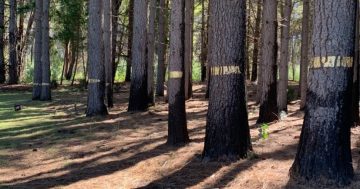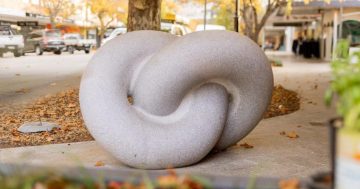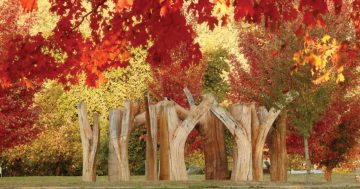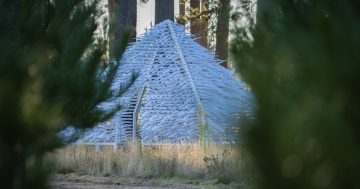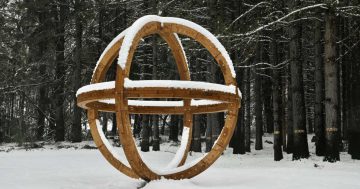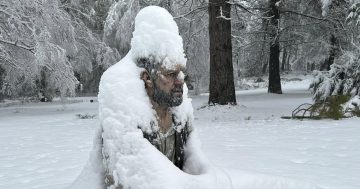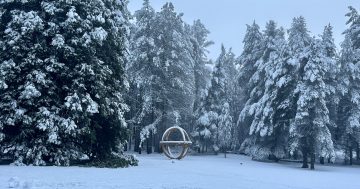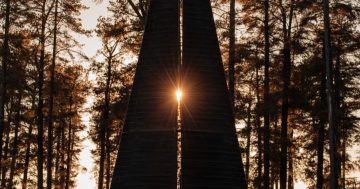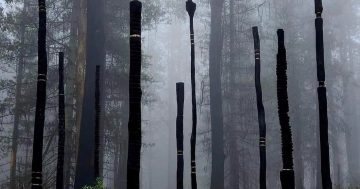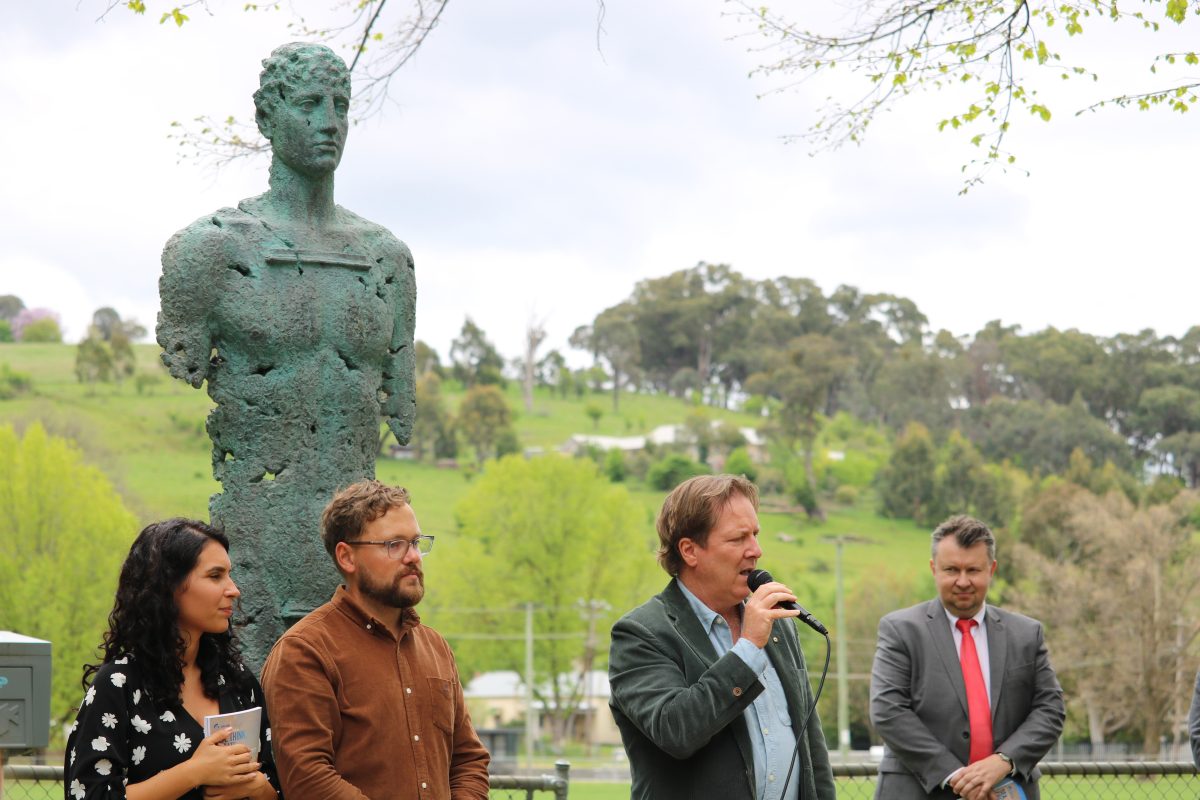
Sculpture by the Sea founder and CEO David Handley at the launch of Egor Zigura’s Colossus, at Tumbarumba in 2022. Photo: John Riddell.
In January 2020, the Black Summer bushfires swept through the Snowy Mountains, reducing much of its lush landscape to smouldering ash. Homes were destroyed, wildlife vanished and the local economy, heavily reliant on tourism, was left in ruins.
Yet, from that scorched, scarred earth, an idea took root in the mind of one man with a 25-year dream of a major public sculpture collection in the Australian bush.
David Handley is the founder and CEO of the enormously popular Sculpture by the Sea public art exhibitions held annually at Bondi in Sydney and Cottesloe in Western Australia.
“After seeing the people of Sydney respond to Sculpture by the Sea with so much enthusiasm, I believed people in the bush would also respond well to sculptures in their backyard if the project was presented to them in a way whereby they felt included and could, in their own way, enjoy the sculptures,” he said.
His quest ended with his first visit to the Snowy Valleys in June of 2020.
David would see past the sickeningly blackened leafless lifeless trees and landscape to the grand vistas, sweeping valleys, warmhearted strong-spirited people, the nascent food and wine trail, fall in love and map out a plan for a place where creativity and healing might flourish together.
The idea of creating a sculpture trail in a fire-ravaged area initially raised eyebrows.
“At first, it felt like a strange response to such devastation,” he admitted.
It had originated from local feedback, after David initially pitched a sculpture park that was met with resistance.
But conversations with local leaders and residents led to a collaborative vision that was as much about community building as it was about aesthetics.
“This was never about dropping a project into the region,” he said. “It was about building something the locals could truly own.”
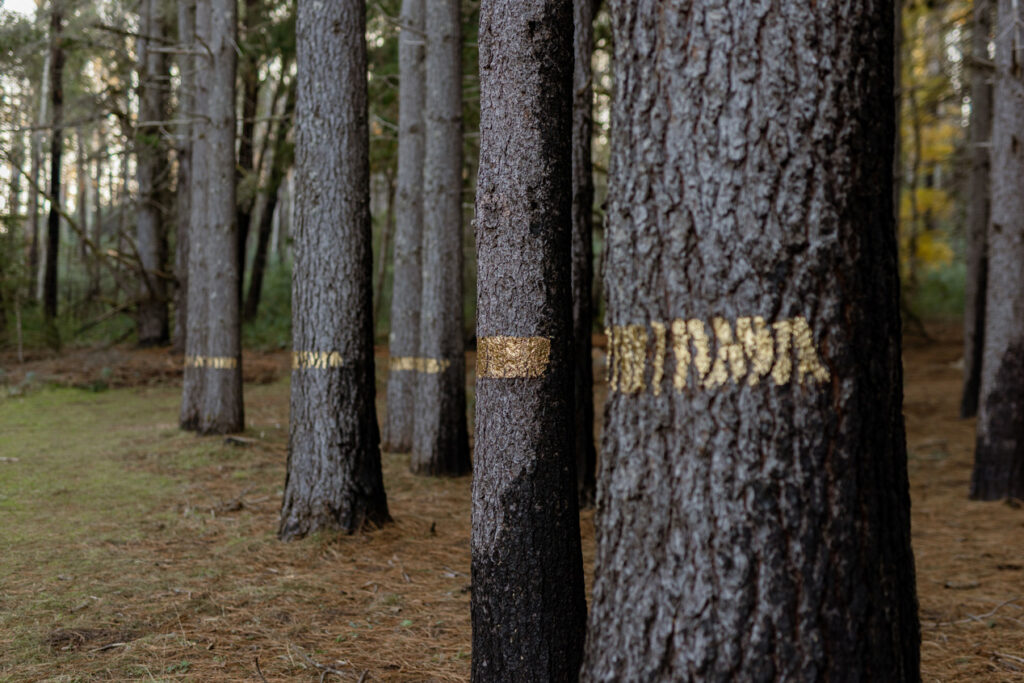
Robyn Veneer Sweeney, Containment Lines, Pilot Hill Arboretum Sculpture Forest. Photo: Grant Hardwick.
Five years on, with 55 large-scale sculptures made by national and international artists, their collective vision has slowly and deliberately unfurled in a 150-kilometre stretch of permanent public art installations known as the Snowy Valleys Sculpture Trail.
What began as a regional recovery initiative has become not only a powerful tool for healing but also a thriving attraction for tens of thousands of national and international visitors.
The sculptures themselves are as varied as the landscape they inhabit. Eastern Riverina artist Robyn Veneer Sweeney’s Containment Lines at the Pilot Hill Arboretum Sculpture Forest references a strategy used by firefighters to contain fires to a specific area and the miracle of the survival of Pilot Hill despite being ringed by fires.
In Tumbarumba, Keld Moseholm’s Together We Are Strong became a symbol of collective resilience.
The list goes on.
David said curating the collection wasn’t without its challenges; the sculptures had to complement the region’s unique alpine environment while withstanding extreme weather conditions.
Many artists chose to incorporate salvaged materials from the fires, blending their works with the landscape in a literal and symbolic sense, he said.
And while not everyone shares the same taste, Handley acknowledges the importance of variety in the collection.
“We deliberately curated a wide range of works so that everyone could find something they love. Some sculptures, over time, become like an old pair of boots — you might not notice them at first, but eventually, they make you feel good just by being there.”
He said the response had been overwhelmingly positive.
“It’s not just tourists coming in; locals are telling each other about the trail and sharing their excitement,” he said. “That’s how you know it’s working.”
You don’t have to drive far to see or hear of the significance of the trail to locals.
Cathy Gairn, at Courabyra Wines, reported an uptick of 40 people each week visiting her restaurant and cellar door specifically to experience the sculptures.
Perhaps the most telling anecdote, however, comes from the publicans at The Batlow Hotel, who noticed a steady stream of visitors stopping to photograph Jina Lee’s stone sculpture in the town’s centre.
“In one 40-hour period, 57 cars stopped just to take a photo of that piece,” David said. “It’s incredible to see how art has captured the attention of so many people.”
These moments, he believes, show how art can bridge local pride and visitor curiosity.
The trail’s benefits extend beyond foot traffic. A school education program has engaged more than 3000 students across 25 schools since late 2020, with artists leading workshops to inspire creativity.
Snowy Hydro’s sponsorship ensures the program’s future and its expansion to new areas like Cooma.
This effort has shown families that the trail isn’t just an external project but one that invests in their children’s education and creativity.
The significance of the Sculpture Trail became even more evident in a deeply moving example.
A family in Batlow, whose three-year-old son is battling terminal cancer, organised a day-long tour of the sculptures as a fundraiser which raised more than $2500 in a day.
“That kind of response is exactly what we hoped for,” David said. “It shows how art can bring people together, even in the hardest of times.”
The trail continues to grow, with new sculptures being added to the collection regularly.
“Since the trail’s initial launch, we’ve seen the demand for more art in the area with art installations now in Talbingo, Tumut, and even Khancoban will soon be included.”
The project’s success feels like a personal victory for David.
“It has been a humbling privilege to create the Snowy Valleys Sculpture Trail in partnership with the people of the Snowy Valleys as part of the recovery and to leave a legacy of substantial arts and tourism infrastructure,” he said.
“This is a project we have dedicated much of the last five years to realise, and while we are proud of what we have achieved, we are acutely aware this project only came about because of a tragedy.”







